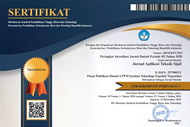Analisis Kerusakan Jalan Menggunakan Metode PCI pada Jalan Perkerasan Kaku
Abstract
Keywords
Full Text:
PDFReferences
T. I. Al-Suleiman, M. T. Obaidat, G. T. Abdul-Jabbar, and T. S. Khedaywi, “Field inspection and laboratory testing of highway pavement rutting,” Can. J. Civ. Eng., vol. 27, no. 6, 2000, doi: 10.1139/cjce-27-6-1109.
S. I. Sarsam, “Pavement maintenance management system : A review,” Trends Transp. Eng. Appl., vol. 3, no. 2, 2016.
M. M. . Zumrawi, “Survey and Evaluation of flexible Pavement Failures,” Int. J. Sci. Res., vol. 4, no. 1, 2015.
F. M. A. Karim, K. A. H. Rubasi, and A. A. Saleh, “The Road Pavement Condition Index (PCI) Evaluation and Maintenance: A Case Study of Yemen,” Organ. Technol. Manag. Constr. an Int. J., vol. 8, no. 1, 2016, doi: 10.1515/otmcj-2016-0008.
P. Zoccali, G. Loprencipe, and A. Galoni, “Sampietrini stone pavements: Distress analysis using pavement condition index method,” Appl. Sci., vol. 7, no. 7, 2017, doi: 10.3390/app7070669.
G. Bonin, S. Polizzotti, G. Loprencipe, N. Folino, C. Oliviero Rossi, and B. B. Teltayev, “Development of a road asset management system in kazakhstan,” in Transport Infrastructure and Systems - Proceedings of the AIIT International Congress on Transport Infrastructure and Systems, TIS 2017, 2017, pp. 537–545, doi: 10.1201/9781315281896-71.
Z. He, X. Qin, H. Wang, and C. Comes, “Implementing Practical Pavement Management Systems for Small Communities: A South Dakota Case Study,” Public Work. Manag. Policy, vol. 22, no. 4, 2017, doi: 10.1177/1087724X17721714.
D. Han and K. Kobayashi, “Criteria for the development and improvement of PMS models,” KSCE J. Civ. Eng., vol. 17, no. 6, 2013, doi: 10.1007/s12205-013-0142-2.
G. Loprencipe, G. Cantisani, and P. Di Mascio, “Global assessment method of road distresses,” 2015, doi: 10.1201/b17618-163.
G. Loprencipe, A. Pantuso, and P. Di Mascio, “Sustainable Pavement Management System in Urban Areas Considering the Vehicle Operating Costs,” Sustain., vol. 9, no. 3, 2017, doi: 10.3390/su9030453.
W. D. Cottrell, S. Bryan, B. R. Chilukuri, V. Kalyani, A. Stevanovic, and J. Wu, “Transportation Infrastructure Maintenance Management: Case Study of a Small Urban City,” J. Infrastruct. Syst., vol. 15, no. 2, 2009, doi: 10.1061/(asce)1076-0342(2009)15:2(120).
“Corrigendum to: International Roughness Index specifications around the world (Road Materials and Pavement Design, (2017), 18, 4, (929-965), 10.1080/14680629.2016.1197144),” Road Materials and Pavement Design, vol. 19, no. 2. 2018, doi: 10.1080/14680629.2017.1383035.
G. Loprencipe and P. Zoccali, “Use of generated artificial road profiles in road roughness evaluation,” J. Mod. Transp., vol. 25, no. 1, 2017, doi: 10.1007/s40534-017-0122-1.
S. A. Arhin, L. N. Williams, A. Ribbiso, and M. F. Anderson, “Predicting Pavement Condition Index Using International Roughness Index in a Dense Urban Area,” J. Civ. Eng. Res., vol. 5, no. 1, pp. 10–17, 2015, [Online]. Available: http://journal.sapub.org/jce.
J. Lin, J.-T. Yau, and L.-H. Hsiao, “Correlation Analysis Between International Roughness Index (IRI) and Pavement Distress by Neural Network,” Transp. Res. Board 82th Annu. Meet., no. January, 2003.
M. Y. Shahin and J. a. Walther, “Pavement Maintenance Management for Roads and Streets Using the PAVER System No. CERL-TR-M-90/05,” US Army Ciros Eng. Constr. Eng. Res. Lab., 1990.
M. Y. Shahin, Pavement management for airports, roads, and parking lots: Second edition. Springer US, 2005.
ASTM, “Standard Test Method for Airport Pavement Condition Index Surveys,” Annu. B. Am. Soc. Test. Mater., no. December, pp. 1–54, 1998.
R. Hafizyar and M. A. Mosaberpanah, “Evaluation of Flexible Road Pavement Condition Index and Life Cycle Cost Analysis of Pavement Maintenance: A Case Study in Kabul Afghanistan,” Int. J. Sci. Eng. Res., vol. 9, no. 8, 2018.
P. Babashamsi, N. I. Md Yusoff, H. Ceylan, N. G. Md Nor, and H. Salarzadeh Jenatabadi, “Evaluation of pavement life cycle cost analysis: Review and analysis,” International Journal of Pavement Research and Technology, vol. 9, no. 4. 2016, doi: 10.1016/j.ijprt.2016.08.004.
DOI: http://dx.doi.org/10.12962%2Fj2579-891X.v22i3.14436
Refbacks
- There are currently no refbacks.

Jurnal Aplikasi Teknik Sipil by Pusat Publikasi Ilmiah LPPM Institut Teknologi Sepuluh Nopember is licensed under a Creative Commons Attribution-ShareAlike 4.0 International License
Based on work at https://iptek.its.ac.id/index.php/jats




